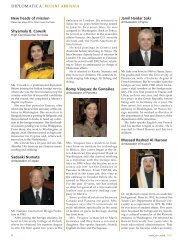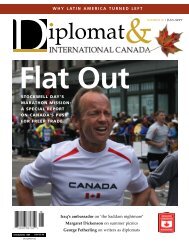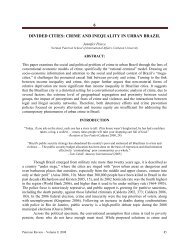the new petro power paradigm - Diplomat Magazine
the new petro power paradigm - Diplomat Magazine
the new petro power paradigm - Diplomat Magazine
Create successful ePaper yourself
Turn your PDF publications into a flip-book with our unique Google optimized e-Paper software.
esponses|Di spatches<br />
embassy of <strong>the</strong> people's republic of CHINA<br />
China: More progress, more ‘opening up’<br />
By Zhang Junsai<br />
October 1 marked <strong>the</strong> 62nd anniversary<br />
of <strong>the</strong> founding of <strong>the</strong><br />
People’s Republic of China. In<br />
those years, and especially over <strong>the</strong> past<br />
33 years since its reform and opening up,<br />
China has awed <strong>the</strong> world with stunning<br />
development. China’s development has<br />
attracted increasing international attention.<br />
How do we view China’s development?<br />
In <strong>the</strong> past 62 years, more than 200 million<br />
Chinese have been lifted out of poverty.<br />
And 1.3 billion Chinese now have enough<br />
to eat. In <strong>the</strong> past 33 years, China’s annual<br />
economic growth reached 9.9 percent.<br />
China’s GDP totaled US$5.88 trillion in<br />
2010, making us <strong>the</strong> world’s second largest<br />
economy. We top <strong>the</strong> world in <strong>the</strong><br />
number of cars produced and sold, as well<br />
as in Internet and cell phone users.<br />
Some believe that with <strong>the</strong> U.S. and<br />
Europe entrenched in <strong>the</strong> sovereign debt<br />
crisis and a lack of economic driving force,<br />
China will soon catch up with <strong>the</strong> West.<br />
This view fails to see China as it is. As<br />
our reform and opening up deepens and<br />
our economy and society develop, China’s<br />
future is ever more interconnected with<br />
that of <strong>the</strong> world. The U.S. and European<br />
debt crisis have harmed <strong>the</strong>ir own economies.<br />
They also show that world economic<br />
recovery is still unstable and uncertain.<br />
China is not an outsider in <strong>the</strong> volatile<br />
global economy. We also face a number<br />
of major challenges. With a population<br />
of 1.3 billion people, our GDP per capita<br />
is US$4,000, ranking 100th internationally,<br />
which is less than one-tenth that of<br />
Canada and even less than that of many<br />
African countries. Based on UN standards,<br />
150 million Chinese — nearly five times<br />
Canada’s total population — still live in<br />
poverty on less than $1 a day. And 10 million<br />
Chinese have no access to electricity.<br />
China needs to provide 24 million jobs<br />
each year. China still suffers from a weak<br />
economic foundation, uneven rural, urban<br />
and regional development, unreasonable<br />
industrial mix and insufficient productivity.<br />
We may be a big country in terms of<br />
population but we are a small country in<br />
terms of economic size per capita. China’s<br />
reality matches our status as a developing<br />
country.<br />
China’s economic and social challenges<br />
are perhaps <strong>the</strong> toughest nut to crack. We<br />
have no reason to be arrogant. It takes<br />
generations to achieve greater prosperity<br />
and to improve <strong>the</strong> Chinese people’s<br />
livelihood. Even when China’s GDP per<br />
capita approximates that of developed<br />
economies, our economy performance and<br />
quality of living will still be far behind.<br />
Is China’s development sustainable?<br />
The answer is yes. No country can avoid<br />
“growing pains.” Just as a train that had<br />
been running at high speed for 30 years<br />
would wear out, <strong>the</strong> problems in our fast<br />
development are natural. It is unwise to<br />
put China’s future path in doubt simply<br />
because of <strong>the</strong>se challenges. China is still<br />
in <strong>the</strong> middle stage of industrialization<br />
and accelerating phase of urbanization.<br />
This means China is still in great need of<br />
infrastructural investment. In <strong>the</strong> next 20<br />
years, we need to help more than 300 million<br />
rural migrants relocate in <strong>the</strong> cities;<br />
upgrade people’s consumption mix from<br />
food and clothing to moderate prosperity;<br />
and reduce <strong>the</strong> development gap between<br />
eastern and western China. Therefore, <strong>the</strong><br />
Chinese economy does not lack <strong>power</strong><br />
or potential. We have every reason to be<br />
optimistic.<br />
China has formulated and is implementing<br />
its twelfth five-year plan, which<br />
calls for faster economic growth mode<br />
transformation. The plan features economic<br />
growth model innovation, social<br />
development and fur<strong>the</strong>r reform and<br />
make your<br />
next event a<br />
masterpiece!<br />
From chic receptions to intimate functions,<br />
from concerts to elaborate banquets, our elegant<br />
spaces offer <strong>the</strong> perfect venue for any occasion.<br />
Our team’s experience assures its success.<br />
380 Sussex Drive, Ottawa 613-991-0000, spevents@gallery.ca<br />
gallery.ca/rentals<br />
diplomat and international canada 53

















